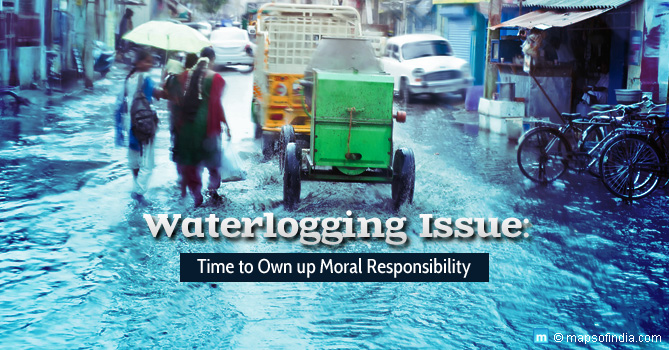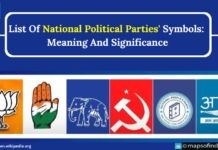The annual problem of waterlogging during monsoons is back in Delhi, as is the blame game that follows. It’s sad to see how tolerant people of the city have become regarding the sheer cussedness of their leaders that they vote for. In equal measure, the leaders too have become insular to the perpetual annual problem knowing perfectly well that the media will make the usual noise and people will raise the odd protest, but this too will pass, once the rains get over and it will be back to business as usual. That’s the way it has been for Delhi, year after year.
The last couple of days in July have seen Delhi receive record rains, resulting in severe waterlogging in many parts and causing traffic jams across the city. In 36 hours, Delhi received over 200 mm rain that proved too much for the city to handle. Unlike other cities in the country that also face severe waterlogging during monsoons, life in Delhi comes to a chaotic standstill even with mild showers. As it happens, the city is just not geared to handle rains, let alone waterlogging.
Low-lying areas along the Yamuna like Yamuna Pushta and Yamuna Vihar traditionally suffer the most, as people need to be evacuated to safer areas each year. This year too was no different, with the Yamuna already flowing near danger levels.
NDMC reported receiving over 90 complaints from areas like Wazirabad, Mori Gate, Jama Masjid, East Patel Nagar, Nangloi, Bawana Gaushala, Pitampura, Rohini and Paschim Vihar.
Traffic jams were reported all over Delhi with the both Ring Road and Outer Ring Road choking at various points. Travellers missed their flights out of Delhi, while many couldn’t make it in time to catch the trains leaving the city. Other people to suffer the most were patients trying to move to and fro from hospitals. Trees were seen uprooted at many places that only added to the woes of the much harried citizens. None of which is new to Delhi and yet no permanent solution has been sought thus far.
The Blame Game Begins
The AAP Government in Delhi was quick to lay blame on the three BJP-dominated civic bodies responsible for maintaining Delhi, for not undertaking de-silting work of the primary and secondary drains well ahead of the monsoon’s arrival. In turn, the BJP was quick to lay blame on the Public Works Department (PWD) saying that many roads that witnessed waterlogging came under PWD’s jurisdiction and they are responsible for the resulting chaos.
Since most municipal drains pour into the larger drains, maintained by PWD, the North Corporation Mayor, Ravinder Gupta directly blamed the PWD for not de-silting the main drains on time. The South Municipal Corporation too laid the blame on PWD saying that they were responsible for the main drains to be cleared on time so that the water from the inner municipal drains could evacuate storm water to the larger drains smoothly.
PWD, on its part, claimed that the de-silting process had been completed well on time but the recent strike by sanitation workers of Delhi resulted in large accumulation of garbage which blocked the drains!
People Suffer Whilst Politicians Spar!
While the politicians lay the blame on each other, the serious fallout of waterlogging is witnessed every year – the dreaded and painful disease ‘Dengue’.
Each year, several fall victim to dengue, which is a vector-borne disease and tends to manifest around stale water. Already 20 cases of Dengue have been reported from the NCR, with 18 from Delhi itself, and this is still the early stage of the monsoon. The seriousness of the problem can be gauged from the statistics on the disease. In 2014, over 1000 cases were reported from the Delhi region.
With this track record, it’s a matter of shame that we the people, allow our politicians to go scot free each year, without anyone taking responsibility for the problem of waterlogging.
So Whose Problem is it Anyways?
Delhi as a city and state suffers from too many masters with no clear accountability. The CM claims that he does not enjoy full powers and his office is perpetually at loggerheads with the Lieutenant Governor and Centre on authority or rather lack of it.
Within the state of Delhi, the ruling power for two consecutive terms was the Congress party, while the municipal bodies have traditionally been BJP strongholds. Each year the hapless people had to witness the passing of buck between the CM’s office and the municipal corporations, with all ultimately pointing fingers at PWD in the end.
Ditto this time around. AAP’s spokesperson Ashish Khetan passed the blame on BJP-dominated municipal corporations, which in turn blamed the PWD and PWD, in turn, blamed the sanitation workers, a new feature this year. And like all years, while they spar, dengue has reared its ugly head with 20 joining the list of victims and more being added to the list each day.
Who Will be Accountable?
So where does this end? Who is to blame for this mess? The politicians, the bureaucrats or we the people, for allowing them to get away each year, without addressing the problem? Arvind Kejriwal came to office offering a lot of hope to the people of Delhi but can he really address this problem by bringing together all the stakeholders to share the responsibility and to ensure that next year will be different? Is that too much to ask of all our leaders?
Rather prematurely, CM Kejriwal tweeted saying that the waterlogging this year was much less and the government had made adequate arrangements to respond to the problem. But tell that to the victims of dengue this year, whose numbers are set to rise as the monsoon season runs its course.
Every time a patient suffers on account of traffic jams caused by waterlogging or a citizen misses a flight or train, someone in office must own up moral responsibility and stand up to say ‘this must end’ but the big question is who will. Meanwhile, the people of Delhi continue to await their Godot.




